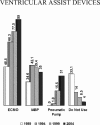Update on pediatric perfusion practice in North America: 2005 survey
- PMID: 16524149
- PMCID: PMC4680823
Update on pediatric perfusion practice in North America: 2005 survey
Abstract
The devices and techniques used for pediatric cardiopulmonary bypass (CPB) undergo continuous change. New techniques and clinical comparisons of devices are frequently reported in the literature; however, information about the extent to which these techniques and devices are adopted into clinical practice at pediatric heart centers are not well described. We conducted a mail survey of North American pediatric cardiac surgery centers to gain perspective on the extent to which various devices and techniques were used for CPB along with program demographic data. In January 2005, surveys were mailed to 180 North American open heart centers. The survey was nearly identical in format and content to three earlier surveys completed in 1989, 1994, and 1999, with the exception that new questions were added to address new techniques and devices that have emerged over the years. Responses were received from 76 hospitals, for an overall response rate of 42%. Of the responding centers, 53 were performing pediatric open heart surgery and 23 were not. Twenty centers performed only pediatric open heart surgery, and 33 performed both pediatric and adult open heart surgery. The mean pediatric annual caseload of responding centers was 195 procedures/yr (range, 20-650 procedures/yr; median, 154 procedures/yr). A total of 9943 pediatric open heart procedures were performed at responding centers in 2004. Most of the centers surveyed reported use of an open venous reservoir system (88%), use of roller pumps (90%), and use of arterial line filtration (98%). Most centers used circuits that have surface treatments with heparin or some other surface-modifying agent (74%). There has been an increase in the use of all types of safety devices. Modified ultrafiltration is used at 75% of the centers surveyed. Centers reported an increase in the availability of all types of cardiac support devices including extracorporeal membrane oxygenation for postcardiotomy cardiac support (90%). This survey provides an overview of clinical practice in 2004. The series of surveys document the historical progression of clinical practice over the past 16 years. Practice surveys may also be useful for identifying gaps between evidence-based knowledge and clinical practice. These surveys document the diffusion of innovation related to CPB during the past 16 years and areas of variation in practice that need further study.
Conflict of interest statement
The senior author has stated that authors have reported no material, financial or other relationship with any healthcare-related business or other entity whose products or services are discussed in this paper.
Figures
Similar articles
-
Pediatric cardiopulmonary bypass devices: trends in device use for cardiopulmonary bypass and postcardiotomy support.ASAIO J. 2005 Sep-Oct;51(5):525-9. doi: 10.1097/01.mat.0000180399.24938.a5. ASAIO J. 2005. PMID: 16322711 Review.
-
A 10-year review of pediatric perfusion practice in North America.Perfusion. 2002 Mar;17(2):83-9. doi: 10.1191/0267659102pf542oa. Perfusion. 2002. PMID: 11958308
-
Pediatric perfusion in Japan: 2010 practice survey.Perfusion. 2012 Jan;27(1):72-7. doi: 10.1177/0267659111424638. Epub 2011 Oct 17. Perfusion. 2012. PMID: 22005885
-
International Pediatric Perfusion Practice: 2016 Survey Results.J Extra Corpor Technol. 2021 Mar;53(1):7-26. doi: 10.1182/ject-2000033. J Extra Corpor Technol. 2021. PMID: 33814602 Free PMC article.
-
Pediatric cardiopulmonary bypass: a review of current practice.Int Anesthesiol Clin. 1996 Spring;34(2):141-63. doi: 10.1097/00004311-199603420-00012. Int Anesthesiol Clin. 1996. PMID: 8799751 Review.
Cited by
-
Adult Clinical Perfusion Practice Survey: 2020 results.J Extra Corpor Technol. 2023 Mar 24;55(1):3-22. doi: 10.1051/ject/2023002. eCollection 2023 Mar. J Extra Corpor Technol. 2023. PMID: 37034099 Free PMC article.
-
Retrospective analysis comparing hollow fiber and silicone membrane oxygenators for neonates on ECMO.J Extra Corpor Technol. 2007 Jun;39(2):71-4. J Extra Corpor Technol. 2007. PMID: 17672186 Free PMC article.
-
Reconstituted fresh whole blood improves clinical outcomes compared with stored component blood therapy for neonates undergoing cardiopulmonary bypass for cardiac surgery: a randomized controlled trial.J Thorac Cardiovasc Surg. 2008 Dec;136(6):1442-9. doi: 10.1016/j.jtcvs.2008.08.044. J Thorac Cardiovasc Surg. 2008. PMID: 19114187 Free PMC article. Clinical Trial.
-
In-vitro quantification of gaseous microemboli in two extracorporeal life support circuits.J Extra Corpor Technol. 2011 Sep;43(3):123-9. J Extra Corpor Technol. 2011. PMID: 22164450 Free PMC article.
-
Neonatal extracorporeal membrane oxygenation devices, techniques and team roles: 2011 survey results of the United States' Extracorporeal Life Support Organization centers.J Extra Corpor Technol. 2011 Dec;43(4):236-44. J Extra Corpor Technol. 2011. PMID: 22416604 Free PMC article.
References
-
- Hill AG, Groom RC, Akl BF, Lefrak EA, Kurusz M.. Current paediatric perfusion practice in North America. Perfusion. 1993;8:27–38. - PubMed
-
- Groom RC, Hill AG, Akl BF, Albus RA, Kurusz M, Lefrak EA.. Neonatal cardiopulmonary bypass—a review of current practice in North America. Cardiol Young. 1993;3:353–69.
-
- Groom RC, Hill AG, Kurusz M, et al. . Paediatric perfusion practice in North America: an update. Perfusion. 1995;10:393–401. - PubMed
-
- Cecere G, Groom RC, Forest R, Quinn R, Morton J.. A 10-year review of pediatric perfusion practice in North America. Perfusion. 2002;17:83–9. - PubMed
MeSH terms
LinkOut - more resources
Full Text Sources
Miscellaneous





